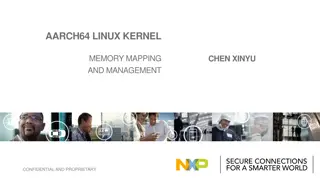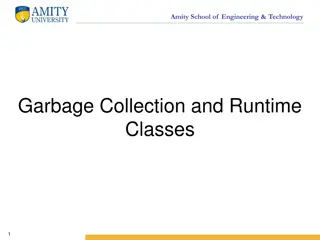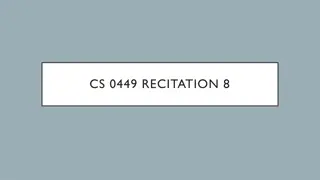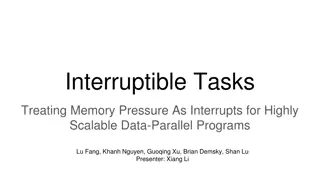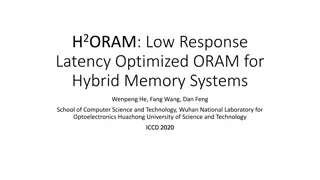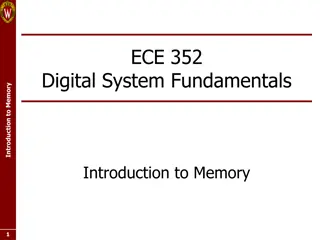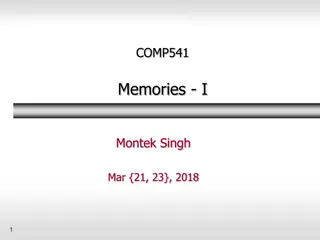
Understanding Memory Management in Operating Systems
Explore the essential functionality of memory management in operating systems, which involves managing primary memory, moving processes between memory and disk, address binding, and more. Learn about main memory (RAM), dynamic loading, dynamic linking, and different types of address binding such as compile time, load time, and execution time.
Download Presentation

Please find below an Image/Link to download the presentation.
The content on the website is provided AS IS for your information and personal use only. It may not be sold, licensed, or shared on other websites without obtaining consent from the author. If you encounter any issues during the download, it is possible that the publisher has removed the file from their server.
You are allowed to download the files provided on this website for personal or commercial use, subject to the condition that they are used lawfully. All files are the property of their respective owners.
The content on the website is provided AS IS for your information and personal use only. It may not be sold, licensed, or shared on other websites without obtaining consent from the author.
E N D
Presentation Transcript
Memory management Memory management is the functionality of an operating system which handles or manages primary memory and moves processes back and forth between main memory and disk during execution. Memory management keeps track of each and every memory location, regardless of either it is allocated to some process or it is free. It checks how much memory is to be allocated to processes. It decides which process will get memory at what time. It tracks whenever some memory gets freed or unallocated and correspondingly it updates the status. The memory management component of an operating system is concerned with the organization and management of system memory. It determines how memory is allocated to processes, responds to constantly changing demands, and interacts with memory management hardware (if present) to maximize efficiency. Main Memory refers to a physical memory that is the internal memory to the computer. The word main is used to distinguish it from external mass storage devices such as disk drives. Main memory is also known as RAM. The computer is able to change only data that is in main memory. Therefore, every program we execute and every file we access must be copied from a storage device into main memory. All the programs are loaded in the main memory for execution. Sometimes complete program is loaded into the memory, but some times a certain part or routine of the program is loaded into the main memory only when it is called by the program, this mechanism is called Dynamic Loading, this enhance the performance. Also, at times one program is dependent on some other program. In such a case, rather than loading all the dependent programs, CPU links the dependent programs to the main executing program when its required. This mechanism is known as Dynamic Linking.
Address Binding Binding is a mapping of address from one address space to another. Address binding is the process of mapping the program's logical or virtual addresses to corresponding physical or main memory addresses. In other words, a given logical address is mapped by the MMU (Memory Management Unit) to a physical address. Address binding relates to how the code of a program is stored in memory. Programs are written in human-readable text, following a series of rules set up by the structural requirements of the programming language, and using keywords that are interpreted into actions by the computer's Central Processing Unit.
Compile Time The first type of address binding is compile time address binding. This allocates a space in memory to the machine code of a computer when the program is compiled to an executable binary file. The address binding allocates a logical address to the starting point of the segment in memory where the object code is stored. The memory allocation is long term and can be altered only by recompiling the program. Load Time If memory allocation is designated at the time the program is allocated, then no program can ever transfer from one computer to another in its compiled state. This is because the executable code will contain memory allocations that may already be in use by other programs on the new computer. In this instance, the program's logical addresses are not bound to physical addresses until the program is invoked and loaded into memory. Execution Time Execution time address binding usually applies only to variables in programs and is the most common form of binding for scripts, which don't get compiled. In this scenario, the program requests memory space for a variable in a program the first time that variable is encountered during the processing of instructions in the script. The memory will allocate space to that variable until the program sequence ends, or unless a specific instruction within the script releases the memory address bound to a variable.
LOGICAL VS. PHYSICAL ADDRESS SPACE Logical Address is generated by CPU while a program is running. The logical address is virtual address as it does not exist physically therefore it is also known as Virtual Address. This address is used as a reference to access the physical memory location by CPU. The term Logical Address Space is used for the set of all logical addresses generated by a programs perspective. The hardware device called Memory-Management Unit is used for mapping logical address to its corresponding physical address. Physical Address identifies a physical location of required data in a memory. The user never directly deals with the physical address but can access by its corresponding logical address. The user program generates the logical address and thinks that the program is running in this logical address but the program needs physical memory for its execution therefore the logical address must be mapped to the physical address bu MMU before they are used. The term Physical Address Space is used for all physical addresses corresponding to the logical addresses in a Logical address space.
Differences Between Logical and Physical Address in Operating System 1. The basic difference between Logical and physical address is that Logical address is generated by CPU in perspective of a program whereas the physical address is a location that exists in the memory unit. 2. Logical Address Space is the set of all logical addresses generated by CPU for a program whereas the set of all physical address mapped to corresponding logical addresses is called Physical Address Space. 3. The logical address does not exist physically in the memory whereas physical address is a location in the memory that can be accessed physically. 4. Identical logical addresses are generated by Compile-time and Load time address binding methods whereas they differs from each other in run-time address binding method. Please refer this for details. 5. The logical address is generated by the CPU while program is running whereas the physical address is computed by the Memory Management Unit (MMU).
BASIS FOR COMPARISON LOGICAL ADDRESS PHYSICAL ADDRESS Basic It is the virtual address generated by CPU The physical address is a location in a memory unit. Address Space Set of all logical addresses generated by CPU in reference to a program is referred as Logical Address Space. Set of all physical addresses mapped to the corresponding logical addresses is referred as Physical Address. Visibility The user can view the logical address of a program. The user can never view physical address of program Access The user uses the logical address to access the physical address. The user can not directly access physical address. Generation The Logical Address is generated by the CPU Physical Address is Computed by MMU
MEMORY ALLOCATION Memory allocation is a process by which computer programs and services are assigned with physical or virtual memory space. Memory allocation is the process of reserving a partial or complete portion of computer memory for the execution of programs and processes. Memory allocation is achieved through a process known as memory management. Static Memory Allocation: The program is allocated memory at compile time. Contiguous memory allocation : is one of the oldest memory allocation schemes. When a process needs to execute, memory is requested by the process. The size of the process is compared with the amount of contiguous main memory available to execute the process. If sufficient contiguous memory is found, the process is allocated memory to start its execution. Otherwise, it is added to a queue of waiting processes until sufficient free contiguous memory is available. Dynamic Memory Allocation: The programs are allocated with memory at run time.
ALLOCATION ALGORITHMS First Fit In the first fit approach is to allocate the first free partition or hole large enough which can accommodate the process. It finishes after finding the first suitable free partition. Best Fit The best fit deals with allocating the smallest free partition which meets the requirement of the requesting process. This algorithm first searches the entire list of free partitions and considers the smallest hole that is adequate. It then tries to find a hole which is close to actual process size needed. Worst fit In worst fit approach is to locate largest available free portion so that the portion left will be big enough to be useful. It is the reverse of best fit. Next fit Next fit is a modified version of first fit. It begins as first fit to find a free partition. When called next time it starts searching from where it left off, not from the beginning.
PAGING Paging is a method of writing data to, and reading it from, secondary storage for use in primary storage, also known as main memory. Paging plays a role in memory management for a computer's OS (operating system). A computer can address more memory than the amount physically installed on the system. This extra memory is actually called virtual memory and it is a section of a hard that's set up to emulate the computer's RAM. Paging technique plays an important role in implementing virtual memory. Paging is a memory management technique in which process address space is broken into blocks of the same size called pages (size is power of 2, between 512 bytes and 8192 bytes). The size of the process is measured in the number of pages. Similarly, main memory is divided into small fixed-sized blocks of (physical) memory called frames and the size of a frame is kept the same as that of a page to have optimum utilization of the main memory and to avoid external fragmentation. Page address is called logical address and represented by page numberand the offset. Logical Address = Page number + page offset Frame address is called physical address and represented by a frame number and the offset. Physical Address = Frame number + page offset A data structure called page map table is used to keep track of the relation between a page of a process to a frame in physical memory.
Advantages and Disadvantages of Paging Paging reduces external fragmentation, but still suffer from internal fragmentation. Paging is simple to implement and assumed as an efficient memory management technique. Due to equal size of the pages and frames, swapping becomes very easy. Page table requires extra memory space, so may not be good for a system having small RAM.
SEGMENTATION Segmentation is one of the most common ways to achieve memory protection. In a computer system using segmentation, an instruction operand that refers to a memory location includes a value that identifies a segment and an offset within that segment. A segment has a set of permissions, and a length, associated with it A process is divided into Segments. The chunks that a program is divided into which are not necessarily all of the same length is called segments. There are types of segmentation: 1 . Virtual memory segmentation Each process is divided into a number of segments, not all of which are resident at any one point in time. 2. Simple segmentation Each process is divided into a number of segments, all of which are loaded into memory at run time, though not necessarily contiguously. Advantages of Segmentation No Internal fragmentation. Segment Table consumes less space in comparison to Page table in paging. It allows to divide the program into modules which provides better visualization. Segment table consumes less space as compared to Page Table in paging. Disadvantage of Segmentation As processes are loaded and removed from the memory, the free memory space is broken into little pieces, causing External fragmentation. Segments of unequal size are not suited for swapping. The time taken to fetch the instruction increases since now two memory accesses are required.
There is no simple relationship between logical addresses and physical addresses in segmentation. A table stores the information about all such segments and is called Segment Table. Segment Table It maps two dimensional Logical address into one dimensional Physical address. It s each table entry has: Base Address: It contains the starting physical address where the segments reside in memory. Limit: It specifies the length of the segment.
Intel Pentium Segmentation + Paging Seg Selector Offset Logical Address Segment Descriptor Global Descriptor Table (GDT) Segment Base Address Linear Address Space Page Dir Physical Address Space Page Table
VIRTUAL MEMORY Virtual Memory is a storage allocation scheme in which secondary memory can be addressed as though it were part of main memory. The addresses a program may use to reference memory are distinguished from the addresses the memory system uses to identify physical storage sites, and program generated addresses are translated automatically to the corresponding machine addresses. The size of virtual storage is limited by the addressing scheme of the computer system and amount of secondary memory is available not by the actual number of the main storage locations. It is a technique that is implemented using both hardware and software. It maps memory addresses used by a program, called virtual addresses, into physical addresses in computer memory. A computer can address more memory than the amount physically installed on the system. This extra memory is actually called virtual memory and it is a section of a hard disk that's set up to emulate the computer's RAM.
Virtual memory is commonly implemented by demand paging. It can also be implemented in a segmentation system. Demand segmentation can also be used to provide virtual memory.
DEMAND PAGING The process of loading the page into memory on demand (whenever page fault occurs) is known as demand paging A demand paging system is quite similar to a paging system with swapping where processes reside in secondary memory and pages are loaded only on demand, not in advance. When a context switch occurs, the operating system does not copy any of the old program s pages out to the disk or any of the new program s pages into the main memory Instead, it just begins executing the new program after loading the first page and fetches that program s pages as they are referenced. While executing a program, if the program references a page which is not available in the main memory because it was swapped out a little ago, the processor treats this invalid memory reference as a page fault and transfers control from the program to the operating system to demand the page back into the memory. Advantages Large virtual memory. More efficient use of memory. There is no limit on degree of multiprogramming. Disadvantages Number of tables and the amount of processor overhead for handling page interrupts are greater than in the case of the simple paged management techniques.
Page replacement Algorithms Page replacement algorithms are the techniques using which an Operating System decides which memory pages to swap out, write to disk when a page of memory needs to be allocated. Paging happens whenever a page fault occurs and a free page cannot be used for allocation purpose accounting to reason that pages are not available or the number of free pages is lower than required pages. When the page that was selected for replacement and was paged out, is referenced again, it has to read in from disk, and this requires for I/O completion. This process determines the quality of the page replacement algorithm: the lesser the time waiting for page-ins, the better is the algorithm. A page replacement algorithm looks at the limited information about accessing the pages provided by hardware, and tries to select which pages should be replaced to minimize the total number of page misses, while balancing it with the costs of primary storage and processor time of the algorithm itself. Reference String - The string of memory references is called reference string. Reference strings are generated artificially or by tracing a given system and recording the address of each memory reference. The latter choice produces a large number of data, where we note two things. Page Fault A page fault happens when a running program accesses a memory page that is mapped into the virtual address space, but not loaded in physical memory.
1. First In First Out (FIFO) algorithm Oldest page in main memory is the one which will be selected for replacement. Easy to implement, keep a list, replace pages from the tail and add new pages at the head. This is the simplest page replacement algorithm. In this algorithm, operating system keeps track of all pages in the memory in a queue, oldest page is in the front of the queue. When a page needs to be replaced page in the front of the queue is selected for removal.
2. Optimal Page algorithm An optimal page-replacement algorithm has the lowest page-fault rate of all algorithms. An optimal page-replacement algorithm exists, and has been called OPT or MIN. Replace the page that will not be used for the longest period of time. Use the time when a page is to be used.
3. Least Recently Used (LRU) algorithm Page which has not been used for the longest time in main memory is the one which will be selected for replacement. Easy to implement, keep a list, replace pages by looking back into time. the page that has not been used for longest period of time is selected for replacement. Although LRU is theoretically realizable, it is not cheap. To fully implement LRU, it is necessary to maintain a linked list of all pages in memory, with the most recently used page at the front and the least recently used page at the rear. The difficulty is that the list must be updated on every memory reference. Finding a page in the list, deleting it, and then moving it to the front is a very time consuming operation, even in hardware (assuming that such hardware could be built).
Virtual Memory in windows Xp. In the Control-Panel, select the System icon: (or right-click "My Computer" on the desk to pand select Properties) Select the tab: "Advanced" and then use in the section "Performance the button "Settings"
In the Window "Performance Options, use the tab : "Advanced In the section "Virtual Memory , the system shows the total size of the Paging file, which you can increase with the "Change" button. Usually, Windows stores the Paging File on drive C:, but if you are short on disk-space on drive C:, you can place a Paging File on a different disk and then decrease the size of the paging file on the C-drive. When using a Application, which use a lot of memory and therefore use heavily the memory emulated by the paging files, it is strongly suggested to increase the "Initial Size" of the Paging file, which reserves already the space on the disk for the page-file.
FILE SYSTEM INTERFACE File-System Interface. For most users, the file system is the most visible aspect of an operating system. ... The file system consists of two distinct parts: a collection of files, each storing related data, and a directory structure, which organizes and provides information about all the files in the system. FILE A file is a named collection of related information that is recorded on secondary storage such as magnetic disks, magnetic tapes and optical disks. In general, a file is a sequence of bits, bytes, lines or records whose meaning is defined by the files creator and user. File Operations Create Write Read Reposition within file file seek Delete Truncate Open(Fi) search the directory structure on disk for entry Fi, and move the content of entry to memory. Close (Fi) move the content of entry Fi in memory to directory structure on disk.
File Type File type refers to the ability of the operating system to distinguish different types of file such as text files source files and binary files etc. Many operating systems support many types of files. Operating system like MS-DOS and UNIX have the following types of files Ordinary files These are the files that contain user information. These may have text, databases or executable program. The user can apply various operations on such files like add, modify, delete or even remove the entire file. Directory files These files contain list of file names and other information related to these files. Special files These files are also known as device files. These files represent physical device like disks, terminals, printers, networks, tape drive etc. These files are of two types terminals or printers. Block special files data is handled in blocks as in the case of disks and tapes. Character special files data is handled character by character as in case of
File Access File access mechanism refers to the manner in which the records of a file may be accessed. There are several ways to access files 1. Sequential access 2. Direct/Random access 3. Indexed sequential access 1. Sequential access :- A sequential access is that in which the records are accessed in some sequence, i.e., the information in the file is processed in order, one record after the other. This access method is the most primitive one. Example: Compilers usually access files in this fashion. 2. Direct/Random access :- Random access file organization provides, accessing the records directly. Each record has its own address on the file with by the help of which it can be directly accessed for reading or writing. The records need not be in any sequence within the file and they need not be in adjacent locations on the storage medium. 3. Indexed sequential access :- This mechanism is built up on base of sequential access. An index is created for each file which contains pointers to various blocks. Index is searched sequentially and its pointer is used to access the file directly.
STRUCTURES OF DIRECTORY A directory is a container that is used to contain folders and file. It organizes files and folders into hierarchical manner. There are several logical structures of directory, 1. Single-level directory 2. Two-level directory 3. Tree-structured directory 4. Acyclic graph directory
1. Single Level Directory Structure This is the simplest directory structure to implement. All files are contained in the same directory. Limitation of single level directory structure is that when number of files increase or when the system has more than one user, it becomes unmanageable. Since all files are in this same directory, the name must be unique. File names are generally selected to reflect the contents of the file, they are often limited in length. Dos allows only 11 character file name and UNIX allows 255 characters.
2. Two Level Directory Structure As we have seen, a single level directory often leads to confusion of files names among different users. the solution to this problem is to create a separate directory for each user. In the two-level directory structure, each user has there own user files directory (UFD). The UFDs has similar structures, but each lists only the files of a single user. system s master file directory (MFD) is searches whenever a new user id=s logged in. The MFD is indexed by username or account number, and each entry points to the UFD for that user. Advantages: We can give full path like /User-name/directory-name/. Different users can have same directory as well as file name. Searching of files become more easy due to path name and user-grouping. Disadvantages: A user is not allowed to share files with other users. Still it not very scalable, two files of the same type cannot be grouped together in the same user.
3. Tree-structured directory Once we have seen a two-level directory as a tree of height 2, the natural generalization is to extend the directory structure to a tree of arbitrary height. This generalization allows the user to create there own subdirectories and to organize on their files accordingly. A tree structure is the most common directory structure. The tree has a root directory, and every file in the system have a unique path. Advantages: Very generalize, since full path name can be given. Very scalable, the probability of name collision is less. Searching becomes very easy, we can use both absolute path as well as relative. Disadvantages: Every file does not fit into the hierarchical model, files may be saved into multiple directories. We can not share files. It is inefficient, because accessing a file may go under multiple directories.
4. Acyclic graph directory An acyclic graph is a graph with no cycle and allows to share subdirectories and files. The same file or subdirectories may be in two different directories. It is a natural generalization of the tree-structured directory. It is used in the situation like when two programmers are working on a joint project and they need to access files. The associated files are stored in a subdirectory, separated them from other projects and files of other programmers since they are working on a joint project so they want to the subdirectories into there own directories. The common subdirectories should be shared. So here we use Acyclic directories. It is the point to note that shared file is not the same as copy file if any programmer makes some changes in the subdirectory it will reflect in both subdirectories.
PROTECTION The processes in an operating system must be protected from one another's activities. To provide such protection, we can use various mechanisms to ensure that only processes that have gained proper authorization from the operating system can operate on the files, memory segments, CPU, and other resources of a system. Protection refers to a mechanism for controlling the access of programs, processes, or users to the resources defined by a computer system. This mechanism must provide a means for specifying the controls to be imposed, together with a means of enforcement. We distinguish between protection and security, which is a measure of confidence that the integrity of a system and its data will be preserved. Authentication One Time passwords Program Threats System Threats
Implementation of File System File Systems are stored on disks. MBR: Master Boot Record is used to boot the computer Partition Table: Partition table is present at the end of MBR. This table gives the starting and ending addresses of each partition. Boot Block: When the computer is booted, the BIOS reads in and executes the MBR. The first thing the MBR program does is locate the active partition, read in its first block, which is called the boot block, and execute it. The program in the boot block loads the operating system contained in that partition. Every partition contains a boot block at the beginning though it does not contain a bootable operating system. Super Block: It contains all the key parameters about the file system and is read into memory when the computer is booted or the file system is first touched.
Allocation Methods An allocation method refers to how disk blocks are allocated for files: 1. Contiguous allocation 2. Linked allocation 3. Indexed allocation 1. Each file occupies a set of contiguous blocks on the disk Simple only starting location (block #) and length (number of blocks) are required Random access Wasteful of space (dynamic storage-allocation problem) Files cannot grow Each file is stored as a contiguous run of disk blocks. Example: On a disk with 1KB blocks, a 50KB file would be allocated 50 consecutive blocks. With 2KB blocks it would be 25 consecutive blocks. Each file begins at the start of a new block, so that if file A is occupying 3 blocks, some space is wasted at the end of the last block. Advantages: Simple to implement. The read performance is excellent because the entire file can be read from the disk in a single operation. Drawbacks: Over the course of time the disk becomes fragmented. Contiguous allocation
2. Linked List Allocation: The second method for storing files is to keep each one as a linked list of disk blocks. The first word of each block is used as a pointer to the next one. The rest of the block is for data. Unlike Contiguous allocation no space is lost in disk fragmentation. Simple need only starting address. In this scheme, each file is a linked list of disk blocks which need not be contiguous. The disk blocks can be scattered The directory entry contains a pointer to the starting and the ending file block. Each block contains a pointer to the next block occupied by the file. Advantages: This is very flexible in terms of file size. File size can be increased easily since the system does not have to look for a contiguous chunk of memory. This method does not suffer from external fragmentation. This makes it relatively better in terms of memory utilization. anywhere on the disk. Disadvantages: Because the file blocks are distributed randomly on the disk, a large number of seeks are needed to access every block individually. This makes linked allocation slower. It does not support random or direct access. We can not directly access the blocks of a file. A block k of a file can be accessed by traversing k blocks sequentially (sequential access ) from the starting block of the file via block pointers. Pointers required in the linked allocation incur some extra overhead.
3. Indexed Allocation In this scheme, a special block known as the Index block contains the pointers to all the blocks occupied by a file. Each file has its own index block. The ith entry in the index block contains the disk address of the ith file block. The directory entry contains the address of the index block as shown in the image: Advantages: This supports direct access to the blocks occupied by the file and therefore provides fast access to the file blocks. It overcomes the problem of external fragmentation. Disadvantages: The pointer overhead for indexed allocation is greater than linked allocation. For very small files, say files that expand only 2-3 blocks, the indexed allocation would keep one entire block (index block) for the pointers which is inefficient in terms of memory utilization. However, in linked allocation we lose the space of only 1 pointer per block.
Free space Management The free space list contains all the records of the free space disk block. Thee free blocks are those which are not allocated to other file or directory. When we create a file we first search for the free space in the memory and then check in the free space list for the required amount of space that we require for our file. if the free space is available then allocate this space to the new file. After that, the allocating space is deleted from the free space list. Whenever we delete a file then its free memory space is added to the free space list. There are some methods or techniques to implement a free space list 1. Bitmap 2. Linked list 3. Grouping 4. Counting 1. Bitmap This technique is used to implement the free space management. When the free space is implemented as the bitmap or bit vector then each block of the disk is represented by a bit. When the block is free its bit is set to 1 and when the block is allocated the bit is set to 0. The main advantage of the bitmap is it is relatively simple and efficient in finding the first free block and also the consecutive free block in the disk. Many computers provide the bit manipulation instruction which is used by the users. Advantages: This technique is relatively simple. This technique is very efficient to find the free space on the disk. Disadvantages: This technique requires a special hardware support to find the first 1 in a word it is not 0. This technique is not useful for the larger disks.
2. Linked list the free disk blocks are linked together i.e. a free block contains a pointer to the next free block. The block number of the very first disk block is stored at a separate location on disk and is also cached in memory. 3. Grouping This approach stores the address of the free blocks in the first free block. The first free block stores the address of some, say n free blocks. Out of these n blocks, the first n-1 blocks are actually free and the last block contains the address of next free n blocks. An advantage of this approach is that the addresses of a group of free disk blocks can be found easily. 4. Counting This approach stores the address of the first free disk block and a number n of free contiguous disk blocks that follow the first block. Every entry in the list would contain: Address of first free disk block A number n.
https://www.tutorialspoint.com/operating_system/os_memory_management.htmhttps://www.tutorialspoint.com/operating_system/os_memory_management.htm https://techdifferences.com/difference-between-logical-and-physical-address.html https://www.geeksforgeeks.org/logical-vs-physical-address-in-operating-system/ https://www.tutorialspoint.com/operating_system/os_memory_management.htm https://www.geeksforgeeks.org/operating-systems-segmentation/ https://www.tutorialspoint.com/operating_system/os_virtual_memory.htm https://www.tutorialspoint.com/operating_system/os_file_system.htm




